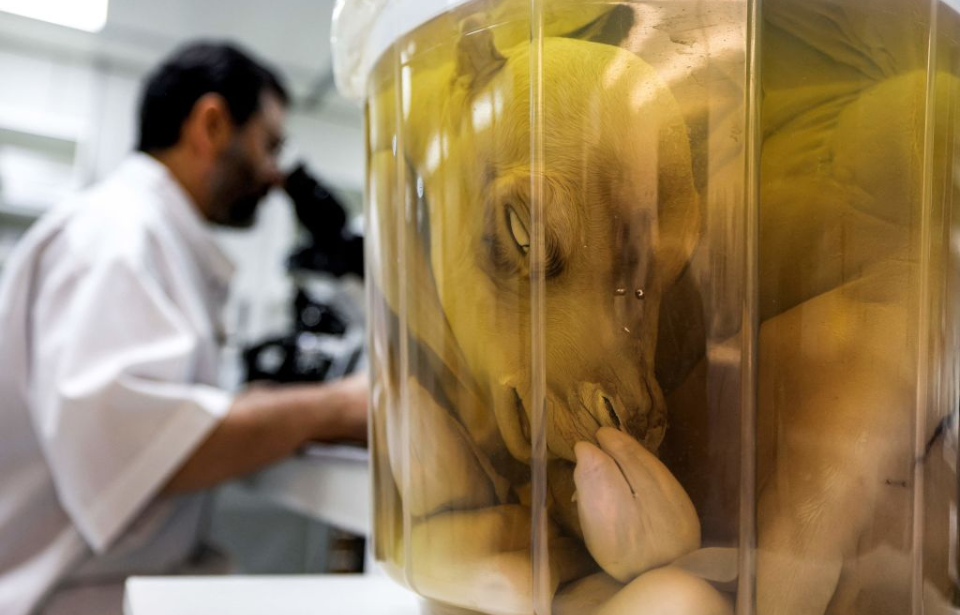Dubai has been cloning camels for almost 15 years. After improving upon the science, the practice has become a business venture. Camel cloning is done for a multitude of reasons, including the potential betterment of the species, as well as for more leisurely motivations. As the process continues to develop, we can only expect to see more clones out in the world, but who can tell when they all look the same?
Cloning the first camel

In 2009, Nisar Ahmad Wani succeeded in cloning the world’s first camel, named Injaz. The scientific achievement was carried out at the Reproductive Biotechnology Center in Dubai. Injaz produced three offspring, proving that cloned camels could naturally conceive.
It was during her fourth pregnancy that complications arose, as she was carrying a calf that was too big for her. This caused both Injaz and her unborn calf to die. Her passing had a profound effect on Wani, who explained in an interview with Wired, “It’s hard work to produce a camel and when it dies, I feel pain.”
Since producing the first cloned camel, Wani has become the Reproductive Biotechnology Center’s scientific director, and he and his team continue to produce 20-25 cloned dromedary camels every year. They’re also capable of cloning other animals, such as buffalo and sheep.
This futuristic process is achieved by gathering DNA from the donor animal and introducing it to an egg, as Wani explained to CNN. “The DNA from the somatic [non-reproductive] cell starts behaving like the DNA of an embryo. Once activated, they are cultured in a lab for seven to eight days before being transferred to the uterus of a surrogate mother.”
Once the baby camel is born, it has all of the genes of the donor animal.
Camel cloning has become a profitable business

As incredible a scientific feat as camel cloning is, the Reproductive Biotechnology Center wasn’t established for the advancement of science. Instead, the Crown Prince of Dubai opened it to clone top-level racing camels. Cloning creates the same animal multiple times over, giving a higher chance of owning an equally successful racing camel if the DNA used is from a victor.
Camel beauty pageants are another reason camel cloning has become so popular in Dubai. In the past, some owners have been disqualified for trying to physically alter the look of their animals using silicone and fillers. With substantial monetary prizes up for grabs, reproducing an exact copy of an award-winning camel is a no-brainer.
Entering cloned camels in these beauty pageants isn’t against the rules, either. It is, however, an expensive endeavor that can cost owners between $54,500 and $109,000 USD.
Wani and his team also work with bereaved pet owners to recreate their beloved pals. The cell samples necessary to produce a clone can be retrieved from the corpse of the donor animal shortly after death, meaning owners can be reunited with an exact replica of their pet.
Camels are an important part of Dubai’s culture

Camels are deeply ingrained in Dubai’s culture. Not only were they an essential source of milk and meat, they facilitated long-haul transportation in the deserts of Arabia.
“Camels were an essential element to ensuring life was possible in the Arabian Peninsula prior to the era of oil and gas,” Obaid Al Falasi, the co-founder of the Arabian Desert Camel Riding Center, told CNN. “Traveling and trade between countries and settlements was facilitated by camels, who had the ability to endure the rough climate and survive on very little feed and water.”
Camels also hold a spiritual significance, along with their physical importance, with Al Falasi saying, “Camels are mentioned in the Quran and described many times as unique compared to other animals, with abilities given by God – like survival without water and food.”
It may strike some as odd that the cloning of such a religiously important creature could be considered non-sacrilegious, but as Al Falasi explained, “Cloning is a scientific achievement in its own and should be considered as such.”
Embryo transfer is another option

Cloning is not a perfect science. The process is extremely delicate and easily ruined, and success for cloned pregnancies is just 10 percent. Compared to the success of natural pregnancies (60 percent), there’s a lot of room for improving the science, and even if they’re successful, there’s less of a chance the cloned camels will survive past infancy.
Not only is the process temperamental, it’s also pretty costly. Most people can’t afford to have their favorite camel’s DNA stored for $4,000, let alone pay to have it processed.
As such, Dubai’s Camel Breeding Center and the Reproductive Biotechnology Center also work with embryo transfer technologies “to ensure that a good camel can produce more offspring [through surrogacy], instead of every year or two.” Such a procedure harvests the embryo of one female and implants it into another, improving the chances of reproduction.
Could this technology save endangered animals?

One way Wani and his team are employing cloning technology is to help save endangered species – specifically, the two-humped Bactrian camel, one of the most endangered mammals on the planet. In 2017, they successfully cloned the first one by implanting an embryo into a dromedary camel that served as a surrogate.
Speaking with CNN, he explained, “Our center is focused on developing and applying the latest reproductive biotechnology techniques like cloning, IVF, artificial insemination and embryo transfer to enhance the multiplication of different animal species of the region and also for the conservation of endangered species.”
More from us: 6 of the Most Eerie Ghost Ships Ever Discovered at Sea
Some scientists worry that prolonged use of such cloning technology may contrarily lead to species extinction through “genetic bottlenecking,” given that each clone is made up of similar – and, in some cases, the exact same – genetic makeup. Despite these concerns, Wani is optimistic that such techniques could even be used to help bring back extinct species.
